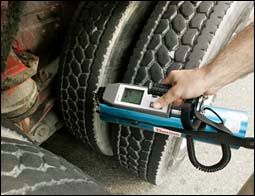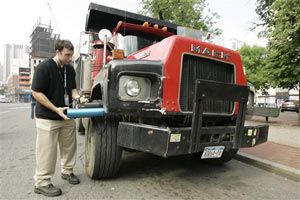By TOM HAYS
The Associated Press
NEW YORK — Days after authorities announced a suspected terrorist plot targeting Kennedy Airport, police at a security checkpoint in lower Manhattan were confronted with another threat: a grimy, radioactive truck.
 (AP Photo/Mary Altaffer) |
“We have a mystery vehicle here,” Deputy Inspector Hugh O’Rourke observed as his radiation detector crackled with a reading three times above normal.
O’Rourke’s concern eased after officers discovered that the truck carried a bulky industrial vacuum used to clean out boilers. Isotopes from soot caused the high reading.
Though the truck was harmless, the inspection illustrated the New York Police Department’s fear that the ragtag collection of commercial trucks rumbling through the city each day could be instruments of terror. In response, police have stepped up inspections and introduced an array of new technology to thwart possible plots.
“We’ve always been concerned about the potential for trucks and other vehicles to be used to convey explosives or other weapons,” Police Commissioner Raymond Kelly said. “We also want to screen against the possibility of sensitive cargos being diverted for use in an attack.”
 Detective Michael Bak, with the New York City Counter Terrorism Unit, uses a device to inspect a truck for radiation at a checkpoint near the Holland tunnel, earlier this month, in New York. (AP Photo/Mary Altaffer) |
The department has made safety inspections of trucks for years, looking for worn-out brakes and other defects that could cause accidents.
But now when vehicles are diverted into checkpoints, NYPD officers subject the vehicles to a separate battery of tests designed to detect radiation and explosives such as the fertilizer-based bombs used to attack the World Trade Center in 1993 and the federal building in Oklahoma City in 1995.
The NYPD recently put more emphasis on screening shipments of chlorine after learning that it has become a favored component of homemade bombs in Iraq. A recent U.N. report found that at least 10 attacks there involved explosives attached to chlorine canisters.
Chlorine typically is used as a disinfectant or purifier, and as an ingredient in plastics and other products. While routinely transported in liquid form, it can turn into a deadly toxic gas when exposed to air.
Any truck driver transporting chlorine canisters who cannot produce proper identification and paperwork accounting for their cargo “would have some explaining to do,” O’Rourke said. And without a good explanation, “The truck gets taken off the road,” he added.
The screeners also pay close attention to dump and cement trucks because “they’re hulking, they’re heavy, they can smash through security checkpoints,” said Jonathan Duecker, an NYPD counterterrorism official.
The 36,000-officer department, the nation’s largest, has been developing mobile radiation detectors that can be mounted on cars or bicycles to alert officers to evidence of a “dirty bomb,” an explosive designed to contaminate areas with radioactive dust and debris. Another version would be worn like a backpack by officers patrolling Yankee Stadium and other venues.
Officers on the streets and in the subways also have begun wearing pagerlike radiation detectors on their belts. About 1,000 of the devices have been deployed; another 1,000 have been ordered.
The NYPD’s six helicopters are being fitted with automatic license-plate readers — already installed in some patrol cars — for flights over bridges, power plants and chemical storage facilities.
During the truck inspections, technicians with larger, handheld radiation detectors circle the trucks. Officers also run swabs over the steering wheels, then insert them into another device that reads for traces of bomb-making materials.
“I tell the drivers I’m checking for explosives and they’re like, ‘Yeah, right,’ “Detective Lisa Gomez said while inspecting a delivery truck.
Paul Sheldon, the driver of the truck that caused the momentary radiation alert, said he understood the NYPD’s vigilance, especially after news of the alleged plot to blow up the aviation fuel system at Kennedy Airport.

